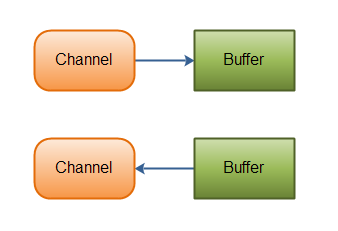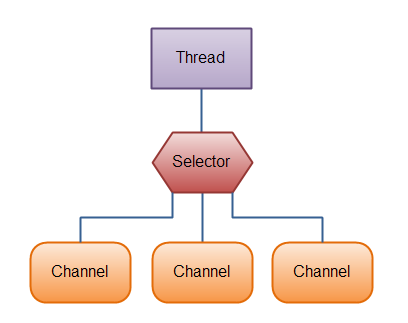Java NIO Overview
来源:互联网 发布:firebird sql server 编辑:程序博客网 时间:2024/05/18 02:26
Java NIO consist of the following core components:
- Channels
- Buffers
- Selectors
Java NIO has more classes and components than these, but the Channel, Buffer and Selector forms the core of the API, in my opinion. The rest of the components, like Pipe and FileLock are merely utility classes to be used in conjunction with the three core components. Therefore, I'll focus on these three components in this NIO overview. The other components are explained in their own texts elsewhere in this tutorial. See the menu at the top corner of this page.
Channels and Buffers
Typically, all IO in NIO starts with a Channel. A Channel is a bit like a stream. From the Channel data can be read into a Buffer. Data can also be written from a Buffer into a Channel. Here is an illustration of that:
 Java NIO: Channels read data into Buffers, and Buffers write data into Channels
Java NIO: Channels read data into Buffers, and Buffers write data into ChannelsThere are several Channel and Buffer types. Here is a list of the primary Channel implementations in Java NIO:
- FileChannel
- DatagramChannel
- SocketChannel
- ServerSocketChannel
As you can see, these channels cover UDP + TCP network IO, and file IO.
There are a few interesting interfaces accompanying these classes too, but I'll keep them out of this Java NIO overview for simplicity's sake. They'll be explained where relevant, in other texts of this Java NIO tutorial.
Here is a list of the core Buffer implementations in Java NIO:
- ByteBuffer
- CharBuffer
- DoubleBuffer
- FloatBuffer
- IntBuffer
- LongBuffer
- ShortBuffer
These Buffer's cover the basic data types that you can send via IO: byte, short, int, long, float, double and characters.
Java NIO also has a MappedByteBuffer which is used in conjunction with memory mapped files. I'll leave thisBuffer out of this overview though.
Selectors
A Selector allows a single thread to handle multiple Channel's. This is handy if your application has many connections (Channels) open, but only has low traffic on each connection. For instance, in a chat server.
Here is an illustration of a thread using a Selector to handle 3 Channel's:
 Java NIO: A Thread uses a Selector to handle 3 Channel's
Java NIO: A Thread uses a Selector to handle 3 Channel'sTo use a Selector you register the Channel's with it. Then you call it's select() method. This method will block until there is an event ready for one of the registered channels. Once the method returns, the thread can then process these events. Examples of events are incoming connection, data received etc.
- Java NIO Overview
- Java NIO(2-Overview)
- Java NIO Overview
- Java NIO Overview
- Java NIO Overview
- Java NIO Overview
- Java NIO Overview
- Java NIO Tutorial 2- Java NIO Overview
- 【JAVA】【NIO】2、Java NIO Overview
- Java NIO之 Java NIO Overview(译)
- Java Overview
- JAVA web service --- overview
- Java Servlet Technology Overview
- JAVA web service --- overview
- JAVA web service --- overview
- Java Annotation Overview
- Java I/O Overview
- Java IO Overview
- SIP相关的RFC文档索引
- 爬虫爬去豆瓣书的目录
- Microservices
- mysql创建utf-8字符集数据库
- 第十九天学习笔记
- Java NIO Overview
- 校验日期格式为yyyy-MM-dd
- 成员变量多态问题
- Android面试指南-面霸之路09-经验分享
- 激活idea15.0方法
- Cocos2d-x 3.x 生成和加载plist文件
- poj 2773 容斥原理+二分(求与n的第k互质数)
- Hexo主题Yelee介绍
- Mycat安装


